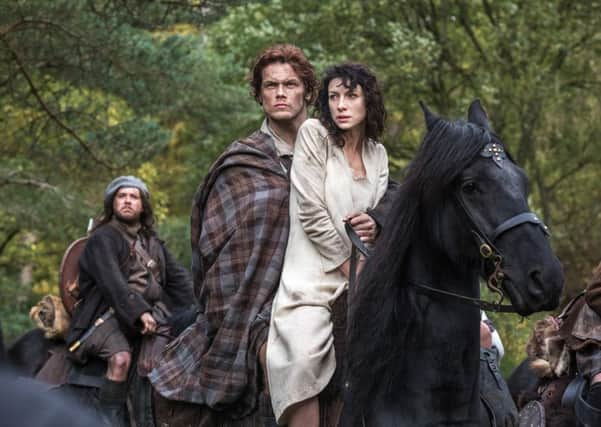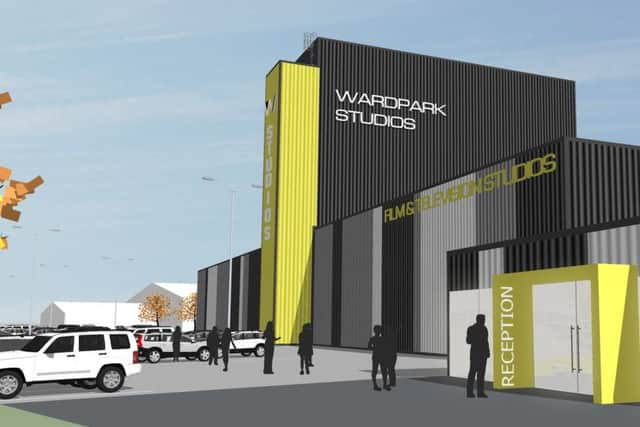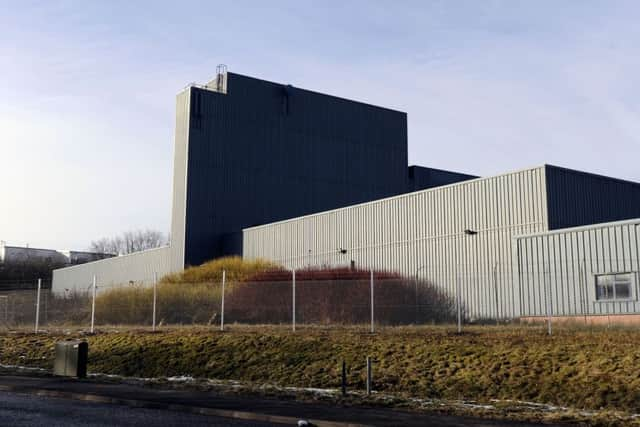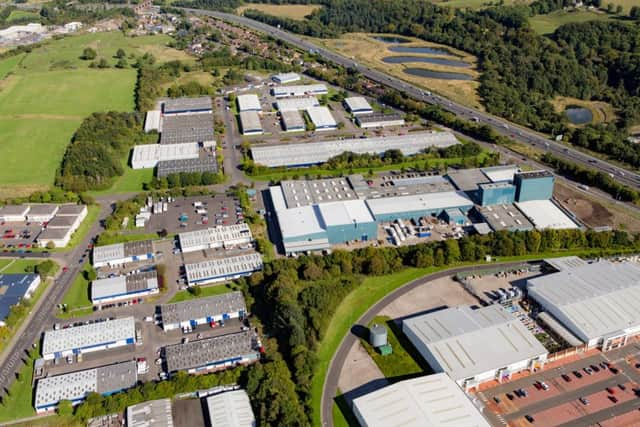Outlander HQ backed to become Scots film studio by Scottish Government


The owners of a vast warehouse complex in Cumbernauld, which is currently used as a temporary base for the hit American TV show Outlander, have unveiled plans to retain and hugely expand the facilities there.
Six sound stages up to 50 feet tall would be available for blockbuster films and high-quality television series at the Wardpark Studios complex, located just off the M80 motorway.
Advertisement
Hide Ad

The prospect of a studio in Cumbernauld has been supported by North Lanarkshire Council, which has been competing with Glasgow City Council to secure the country’s first permanent studio.
However industry campaigners said the new facilities in Cumbernauld would “not go far enough” to help Scotland compete with its major rivals around the UK and further afield.
The Association of Film and Television Practitioners in Scotland has urged the government to endorse a separate scheme for a privately-funded film studio being pursued on the outskirts of Edinburgh.
Plans will be lodged this week for the relocation of an existing car park at the Wardpark site to make way for a £5 million purpose-built complex - which would be the first facility of its kind in Scotland. It is thought work could get underway within the next year, if planning permission is secured.


The new complex, which will get around £4 million worth of public backing, would add around 30,000 sq ft of studio space, which can be used for two different productions, to the four sound stages which have been built in the last three years for Outlander, which make up another 48,000 sq ft.
Details of the development were announced by culture secretary Fiona Hyslop at Holyrood after agreement in principle on a funding package was reached with the Scottish Government, Scottish Enterprise and arts agency Creative Scotland following more than a year of complex negotiations.
Advertisement
Hide AdBusinessman Terry Thomson - who snapped up the former Isola factory on the Wardpark Industrial Estate in 2013, shortly before receiving an approach over its possible use for the Sony-Starz TV series - revealed he had reached agreement with the programme makers to keep all the existing facilities there intact.


He insisted a “a permanent film studio” was already in place at every Cumbernauld, with “every square foot of space we have at the moment now in use by the production.” He said the current facilities were insured for £35 million.
Advertisement
Hide AdHowever it is not known how long Outlander will continue to be based in Cumbernauld as filming on the second series has only just been completed and there are eight books so far in the best-selling series by American author Diana Gabaldon which are being adapted for the lavish TV show. The second series will be premiered next month.
Mr Thomson said Outlander would be “welcomed with open arms” if a third season was commissioned and the production wanted to return to Cumbernauld.
Under the proposed financial deal, £1.5m in direct funding will be provided, to ensure the development complies with strict EU funding rules over the support of studio developments. A further loan of around £2.5 million is expected to be approved.


Mr Thomson said he wanted to prepare for a “post-Outlander” future at Cumbernauld by creating the new sound stages, and hinted there could be room for even further expansion on adjacent sites.
He added: “We want to enhance the existing four sound stages with a further two, to expand and grow productions using the facility.
“With each production using the site, the benefits to the local and national economy are increased, reaching far beyond simply the studio and deep into the supply chain.
Advertisement
Hide Ad“Lighting and rigging suppliers, local builders’ merchants, landscaping suppliers, transport suppliers and many others provide the products and services that ensure these global productions can be made right here in Scotland.
“Our planning application seeks to make the most of the existing facilities and land available. While we’ve reached agreement in principle on possible financial support, there remain a few commercial details still to be finalised before we can move ahead with our plans.”
Advertisement
Hide AdDavid Smith, director of creative industries at Scottish Enterprise, said the possibility of creating a permanent facility at Wardpark had emerged shortly after previous efforts to secure a deal over an alternative site had to be shelved.


He added: “We’re really excited about the ambition Wardpark Studios has for the site and we’ve been working with them on their business plan to secure further investment in Scotland’s screen infrastructure.
“The company’s plans remain at a critical stage of consideration. But I believe Wardpark Studios’ decision to apply for planning consent to increase the size and scale of the existing facilities in Cumbernauld illustrates their long-term commitment to operate world-class studio facilities in Scotland.
“We remain absolutely committed to doing whatever we can within EU competition rules to ensure additional screen infrastructure is developed in Scotland.”
Ms Hyslop said: “Wardpark Studios’ decision to seek planning consent for new studio facilities in Cumbernauld marks an important milestone in our work to strengthen the Scottish screen sector.
“We’re seeing significantly increased activity in our screen sector. Film and TV producers spent an unprecedented £45.8 million shooting on location in Scotland in 2014.
Advertisement
Hide Ad“This record total – an increase of almost £12 million compared with 2013 – demonstrates a fast growing appetite for major productions to base themselves in Scotland.
“Scotland’s screen sector offers a wealth of experience and talent, supported by a growing number of facilities companies.
Advertisement
Hide Ad“This, teamed with Scotland’s natural landscapes, impressive portfolio of urban locations, and our firm determination to deliver permanent film studio infrastructure, means we are well placed to ensure Scotland’s screen industry will continue to strengthen.”
News of the government backing for the Cumbernauld site - which a host of international film and TV executives have already been shown around - will be a blow to hopes that a studio could be built on a greenfield in Midlothian.
A consortium behind the Pentland Studios scheme, which is earmarked for the Straiton area, have appealed to the government after failing to win the backing of the local authority amid fears the project would blight the local landscape, cause unacceptable disruption to local residents and hamper other key developments in the area.
However Creative Scotland insisted more than one studio facility was needed to support and attract local, UK and international film and TV productions.
Director of screen Natalie Usher said: “In order to support local productions and attract UK and international productions, Scotland needs a full range of options for stage space and production offices.
“Converted and build space in Scotland that is currently being marketed compares favourably with similar space marketed by other UK nations, but we also need purpose-built space in order to compete effectively.
Advertisement
Hide Ad“We continue to investigate other potential options where there is interest from the market and appetite from private investors.”
A spokesman for the AFTPS group said: “Even with this welcome addition to studio space, Scotland is still far behind other areas of the UK with only half of the dedicated studio space of Northern Ireland and Wales.
Advertisement
Hide Ad“We remain unconvinced that the two government agencies, Creative Scotland and Scottish Enterprise, are working effectively as a partnership. Their failure is having a detrimental effect on the economic stability of an industry they know little about.
“It is therefore essential that Scotland has a dedicated screen sector agency that can develop the industry to be competitive nationally and internationally.”
North Lanarkshire Council Leader Jim Logue said: “The scale of the hoped-for expansion at the Wardpark Studios presents a tremendous opportunity for Cumbernauld and North Lanarkshire.
“We are, potentially, looking at hundreds of jobs and tens of millions of pounds pumped into the local economy over the next two decades.
“On a single day, as many as 300 people could be working on site. We have already been working closely with the studio owner and have built a strong relationship.
“For all the glamour of a film and TV production facility on our doorstep, the reality is in the number of tradesmen and women who will benefit; electricians, painters, plasterers and joiners before we even think about the specialist technical roles associated with a studio.
“North Lanarkshire enjoys tremendous transport and communications links which film and TV can only benefit from.”
